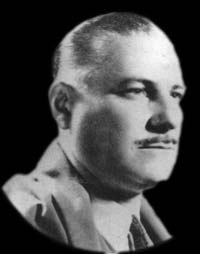By
Osvaldo Sosa Cordero, folk musician and tango man

was born in Yaguareté Corá, province of Corrientes, but before I was nine I was already based in Buenos Aires with my family. I arrived at a time when tango was banned but it began to be heard, especially, after Gardel made a hit with “Mi noche triste (Lita)”.
«I had brought from Corrientes a kind of music that was limited to a very few pieces that were played in the interior of the country. At the farms, at the estancias, in the little ranches there was always a small two-row accordion.
 «In my childhood days I first heard Juan Maglio, Vicente Greco, Francisco Canaro. Numbers like “El pollito”, “El apache argentino” (a boom), “La payanca”, “El incendio”, “La guitarrita”, “El Marne” were all part of my tango background.
«In my childhood days I first heard Juan Maglio, Vicente Greco, Francisco Canaro. Numbers like “El pollito”, “El apache argentino” (a boom), “La payanca”, “El incendio”, “La guitarrita”, “El Marne” were all part of my tango background.
«All those recordings my father had bought I still keep them. He played by ear several instruments and my eldest sister and I were the only ones among nine siblings who were fond of music. She used to play fashionable tangos on piano and then I could not resist, I began to have tango with me. My first direct contact was as dancer when I was a teenager but I had to improve to dare to dance at a cabaret track. At those places the tango music played was not the one from the outskirts but a polished tango, the tango for dancehalls played by the orchestras led by Canaro, Julio De Caro or Osvaldo Fresedo.
«My first composition is not a tango but a polka-song that evokes my hometown and is called “Camba cuá”. Later I began to collaborate with Samuel Aguayo until the art director of the Victor house, Juan Carlos Casas suggested to me writing songs for Aguayo but not in Guarani. So was born “La naranjerita”. Soon thereafter it was the Odeon label which hired me to put together the group “Osvaldo Sosa Cordero y sus correntinos”, exclusively for recording.
«The first tango was “Cotorrito bohemio”, later “Labios vírgenes” and thereafter “Embrujado [b]”, all with music by Francisco Oréfice who was member of several orchestras, such as the ones led by Pedro Laurenz and by José Basso, as lead violin. I also wrote the milonga “Clavel”, with music by Miguel Bucino which was recorded by Juan D’Arienzo in 1944 with Alberto Echagüe on vocals. With the pianist José Ceglie I composed “De pura cepa”. Two great hits with Alberto Castillo were the candombes “Café [b]” and “Charol”. Others were “Yumbambé”, “Mozambique”, the tangos “Yo llevo un tango en el alma”, “Santa Paula”, “Para Corrientes”, “Vieja canzoneta”, “Ahí va el dulce”, a beautiful melody by Juan Canaro.
«In the late fifties with Sebastián Piana we won a contest with the tango “Buenas noches Buenos Aires”. Many tango men did not like we were given this award because they thought I was only a folk musician in spite I had always been a tango man.
«I never studied music, I basically play by ear. I was always reluctant to study. I stood away from strict rules and discipline. I would have liked to know it in order to write my things. Once José Bragato told me: «Music is like mathematics. The more you know the more complicated it becomes to be solved. You have a little creative flame and don’t need anything more to go on writing. The day you dive into the world of music the difficulties you’ll have to face will blow out that flame».
«I never put together a tango orchestra. I was nearly twenty years with Los Correntinos, and because of that I was identified with folk music, but I wrote tangos. However in the early forties I wrote a song which was a smash hit, I’m talking about “Anahí”. To such an extent that a married couple wanted to name her daughter after that song. At that time strange names were not allowed but they insisted and as the song was so widely known, finally the Registry Office accepted it.

«The advent of tango-song weakened melodies to emphasize lyrics. But in the twenties there was another landmark because tango became more melodic reaching a certain musical beauty that was never surpassed. There was a decline in the following decade, the thirties. The efforts made by Julio De Caro with his Symphony Orchestra were to no avail, but Juan D’Arienzo with his dancing beat turned up and tango regained a mass popularity. From that come the forties, an incomparable breakthrough in its history in which great names paraded and there was a popular liking for dancing. Then came the years of decline in the early sixties.
«In the latter months of 1932 I became friends with Gregor Kalikian, a bandleader of Armenian origin, based in France but that then was appearing at the Cabaret Casanova in Buenos Aires. He was violinist and dancer. He had conducted the orchestra that backed Gardel in his four French songs. He asked me to translate the lyrics into Spanish and, as he was to accompany him again at some appearances, I thought and Gardel accepted that I would write a tango for him. I wrote the lyrics and Gregor with Oréfice composed the music. Previously, on a rainy afternoon we picked him up at the Select Suipacha movie theater, later called Biarritz, and on a taxi cab we went to his house on Jean Jaures 735. There we agreed everything. It became the tango “Embrujo [b]” which he premiered at the Broadway movie theater. Later he recorded it but it was never released».
Excerpted from: “Tango, un siglo de historia, 1880-1980”.